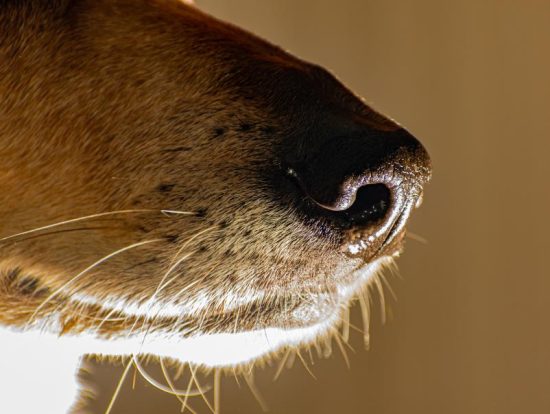Why Do Dogs Have Whiskers? The Purpose Explained
Discover the critical role whiskers play in your dog’s sensory capabilities and how they navigate their world. Learn why do dogs have whiskers.

Have you ever wondered why dogs have those long, wiry hairs sticking out from their face? Those are whiskers, or vibrissae, and they serve a much greater purpose than you might think. These specialized hairs, found above their eyes and on their cheeks, muzzle, and chin, play a crucial role in a dog’s sensory capabilities, allowing them to navigate their environment, detect objects, sense air currents, and even communicate their emotions. But why do dogs have whiskers? Let’s delve into the fascinating world of dog whiskers and uncover their hidden secrets.
Understanding Dog Whiskers: Nature’s Sensory Tool
When it comes to understanding a dog’s sensory capabilities, dog whiskers, also known as vibrissae, play a vital role. These specialized hairs have unique anatomical characteristics that set them apart from regular dog hair.
Vibrissae have deeper roots, thicker shafts, and are packed with blood vessels and nerves, making them highly sensitive. Unlike regular hair that covers the entire body, whiskers are strategically located in specific areas of a dog’s face. They can be found above the eyes, on the chin, and above the upper lip.
The Anatomical Structure of Whiskers in Dogs

Dog whiskers have a more robust structure compared to regular hair. The deeper roots of whiskers allow them to grow from dense nerve endings, providing dogs with heightened sensitivity. Additionally, the thicker shafts of whiskers make them more rigid and less prone to bending. The differences between whiskers and regular dog hair go beyond their physical structure. While regular hair serves mainly for insulation and protection, whiskers have a more specialized function. They act as nature’s sensory tool, helping dogs navigate their surroundings, detect objects, and sense air currents.
Whiskers Across Different Dog Breeds
Just like the physical appearances of dogs differ across breeds, so do their whisker variations. The exact pattern and location of whiskers can vary between different dog breeds, contributing to their unique appearances. Some breeds may have longer or more pronounced whiskers, while others may have a different distribution along the face. These variations in whiskers further demonstrate the diversity and complexity of dog physiology.
The Sensitivity of Whiskers: More Than Just Hair
A dog’s whiskers are not just ordinary hair; they are extremely touch-sensitive due to the abundant presence of blood vessels and nerves in the follicles. This unique feature allows whiskers to serve as a powerful sensory tool for dogs in navigating their surroundings and gathering information about their environment.
Why Whiskers are Touch-Sensitive?
The touch sensitivity of dog whiskers is a result of their specialized structure and composition. Each whisker is embedded deep within the skin and connected to a dense network of blood vessels and nerve endings. When a whisker comes into contact with an object or experiences even the slightest movement, it sends signals to sensory cells, triggering a response that helps the dog perceive and interpret their surroundings.
The Role of Blood Vessels and Nerves in Whisker Sensitivity
The blood vessels and nerves present in the whiskers play a vital role in maintaining their sensory functions. The extensive network of blood vessels supplies essential nutrients and oxygen to the whisker follicles, keeping them healthy and active. The nerves, on the other hand, transmit sensory information from the whiskers to the dog’s brain, allowing them to process and make sense of their environment.

| Key Points | Explanation |
|---|---|
| Dog Whisker Function | Dog whiskers help dogs navigate their environment, detect changes in air currents, and gather information about nearby objects. |
| Anatomical Features | Whiskers have a more rigid structure and are deeply embedded in the skin compared to regular hair. They are strategically located on the face. |
| Touch Sensitivity | Whiskers are touch-sensitive due to the presence of abundant blood vessels and nerves in the follicles. |
| Role of Blood Vessels and Nerves | The blood vessels supply nutrients and oxygen to the whisker follicles, while the nerves transmit sensory information to the brain. |
Why Do Dogs Have Whiskers?
Dogs have whiskers for a reason. These specialized hairs serve a crucial purpose in a dog’s sensory system, allowing them to navigate their environment and perceive the world around them. Whiskers play an essential role in two key areas: navigation and environmental perception.
Whiskers act as sensory equipment that helps dogs gather important information about their surroundings. By detecting subtle changes in air currents, whiskers provide dogs with details about the shape, size, and speed of nearby objects. This information is vital for dogs to navigate obstacles, locate prey or food, and avoid potential dangers.
Imagine navigating through a dark room with your eyes closed. It would be challenging to determine the direction of objects or obstacles solely based on touch or sound. Dogs face similar challenges, especially in environments with limited visibility or distractions. Whiskers serve as extra guidance, enhancing a dog’s spatial awareness and helping them make informed decisions in their environment.
How Whiskers Aid in Environmental Perception
Whiskers also play a crucial role in a dog’s perception of their environment. By detecting subtle changes in air currents, whiskers provide valuable information about the immediate surroundings. Dogs can gather information about the presence of nearby objects, the movement of air, and even the presence of potential threats.
Whiskers provide dogs with a form of “whisker vision,” allowing them to sense the shape, size, and speed of objects before coming into physical contact. This early detection system helps dogs maintain a clear picture of their environment, assisting them in avoiding collisions, identifying prey, or locating food sources.

Understanding the purpose and function of dog whiskers is vital for dog owners. It highlights the importance of preserving and caring for their dog’s whiskers, ensuring they can effectively navigate their surroundings and perceive the world in a way that comes naturally to them.
Exploring the Radar-like Capabilities of Canine Whiskers
Canine whiskers possess radar-like capabilities that allow dogs to detect air currents and objects in their environment. Whiskers act as air current detectors, picking up subtle vibrations caused by changes in the air. This helps dogs determine the proximity and location of objects even before they come into physical contact.
Additionally, whiskers assist dogs in low-light conditions, acting as a form of night vision by alerting them to obstacles or prey that might be otherwise difficult to spot. These remarkable sensory features make dog whiskers invaluable tools that enhance their overall perception and navigation abilities.
| Canine Whiskers | Radar Capabilities | Night Vision Assistance |
|---|---|---|
| Highly sensitive hairs | Detect air currents and object proximity | Help spot obstacles and prey in low-light |
| Act as air current detectors | Determine location of objects | Improve spatial awareness |
| Aid in navigation | Enhance sensory perception | Assist in making informed decisions |
By utilizing their whiskers, dogs can effectively navigate their surroundings and obtain valuable information about their environment, ensuring their safety and facilitating their ability to fulfill their natural instincts.
Expressive Whiskers: How Dogs Communicate Emotions
Dog whiskers play a crucial role in communicating emotions. Through subtle movements of their whiskers, dogs are able to convey their feelings and provide insights into their emotional state.
When a dog is happy or curious, their whiskers may elevate, creating a wide-eyed appearance. This elevation of the whiskers is a visual signal that the dog is experiencing positive emotions and is open to interaction.
On the other hand, if a dog feels threatened or anxious, they may flair or twitch their muzzle whiskers downward. This downward movement of the whiskers serves as a clear indication that the dog is feeling uneasy or uncomfortable in the situation.
By being attentive to these subtle whisker movements, dog owners and enthusiasts can better gauge a dog’s emotions and adjust their approach accordingly. This understanding of whisker communication enhances the overall canine-human interaction and contributes to a better bond between dogs and their owners.
| Emotion | Whisker Movement |
|---|---|
| Happiness or curiosity | Elevated whiskers, wide-eyed appearance |
| Threat or anxiety | Flaired or twitched muzzle whiskers, downward movement |
Whiskers as Guard Elements: Protecting a Dog’s Face
Whiskers, also known as vibrissae, serve as important guard elements for a dog’s face, providing a first line of defense against potential harm. These specialized hairs respond to physical stimuli, such as the presence of dust or particles, and trigger a protective reflex in dogs.
When a whisker detects a foreign object, a dog may instinctively blink or shake its head in an attempt to remove the irritant and prevent harm to the eyes. This reflexive action helps safeguard the sensitive structures of the eyes and minimize the risk of injury.
Additionally, whiskers play a crucial role in preventing dogs from getting stuck or causing damage to themselves or their environment. These sensory appendages help dogs gauge narrow spaces or passages, providing them with valuable information about their surroundings and allowing them to navigate safely without getting entangled or causing harm.
How Whiskers Respond to Physical Stimuli

Whiskers are touch-sensitive and possess a high level of responsiveness to physical stimuli. Each whisker is deeply rooted in the skin and densely packed with blood vessels and nerves, making it highly sensitive to even the slightest touch or disturbance in the surrounding environment.
When a whisker comes into contact with an object or encounters changes in air currents, it transmits sensory information to specialized cells called mechanoreceptors. These cells then relay the information to the dog’s brain, allowing them to make rapid assessments and reactions based on the detected stimuli.
The Protective Reflex Triggered by Whiskers
The responsive nature of whiskers leads to the triggering of a protective reflex when they detect a potential threat. This reflex helps dogs avoid harm by prompting immediate actions that remove or minimize the risk of injury.
For example, if a dog’s whiskers sense the presence of an object approaching their face, they may quickly blink or move their head to avert contact and prevent harm to their eyes. This instinctive protective reflex is essential in maintaining the well-being and safety of dogs in their daily interactions with their environment.
| Whisker Reflex | Protective Action |
|---|---|
| Whisker detects a foreign object near the eyes | Dog blinks or shakes its head to remove the irritant |
| Whisker senses a potential entanglement in a narrow space | Dog adjusts its body posture to safely navigate without getting stuck |
| Whisker detects an approaching object or surface | Dog adjusts its movement to avoid collision or damage |
The Potential Consequences of Trimming or Removing Dog Whiskers
Trimming or removing a dog’s whiskers can have negative consequences. It can disrupt a dog’s sensory abilities, impair their balance and coordination, and lead to disorientation. Whisker loss can result in confusion and difficulty navigating their surroundings, impacting their overall quality of life. It is important to understand the potential consequences before considering any action that may affect a dog’s whiskers.
Physiological Significance: The Importance of Whiskers From Birth
Whiskers play a vital role in a dog’s early development, starting from birth. These specialized hairs assist newborn puppies in finding their mother’s nipples and nursing before their eyes are fully open.
Whiskers provide tactile information that helps puppies navigate their surroundings and meet their basic needs. The sensitive touch receptors at the base of each whisker send signals to the brain, allowing puppies to locate their mother’s nipples and feed with ease.
As puppies grow, whiskers continue to play a crucial role in their developmental milestones. They serve as sensory tools that help puppies explore their environment. By brushing against objects, whiskers provide valuable feedback on textures, distances, and obstacles, enabling puppies to learn and adapt.
The importance of whiskers in the early stages of a puppy’s life cannot be emphasized enough. They contribute to the development of sensory perception, spatial awareness, and motor skills. Whiskers help puppies gain confidence and independence as they navigate their expanding world.
| Stage of Development | Role of Whiskers |
|---|---|
| Birth to Nursing | Assist in locating mother’s nipples and nursing |
| Early Exploration | Provide tactile feedback for environmental awareness |
| Motor Development | Aid in spatial awareness and coordination |
During these developmental stages, it is important for pet owners to recognize the significance of whiskers and create a safe and stimulating environment that allows puppies to freely interact with their surroundings. Providing appropriate mental and physical stimulation, along with proper care for their developing whiskers, can help puppies thrive and ensure a healthy start to their lives.
Caring for Your Dog’s Whiskers: Best Practices and Considerations
Proper care of your dog’s whiskers is crucial for maintaining their sensory capabilities and overall well-being. Whiskers, or vibrissae, play a vital role in your dog’s navigation and perception of the world around them. To ensure healthy and functional whiskers, there are some best practices and considerations to keep in mind.
First and foremost, it is important to avoid cutting or plucking your dog’s whiskers. These specialized hairs are deeply rooted and packed with blood vessels and nerves, making them sensitive and essential for sensory input. Removing or trimming whiskers can disrupt your dog’s ability to gather information about their environment and may lead to disorientation.
When handling your dog’s whiskers, it is crucial to be gentle. These delicate sensory tools require care and respect. Avoid pulling or tugging on them, as this can cause discomfort or even pain for your furry friend. Gentle grooming practices that take into consideration the sensitivity of whiskers are recommended.
Incorporating regular grooming routines can help maintain the health of your dog’s whiskers. Brushing their coat gently and using products specifically designed for their sensitive skin can contribute to the overall well-being of their whiskers. By keeping their whiskers clean and free from debris, you can ensure that they function properly, allowing your dog to navigate their world with confidence.
FAQs on why do dogs have whiskers
What is the purpose of dog whiskers?
Dog whiskers, also known as vibrissae, serve multiple purposes and play a critical role in a dog’s sensory capabilities. They help dogs navigate their environment, detect objects, sense air currents, and communicate emotions.
How are dog whiskers different from regular hair?
Dog whiskers have deeper roots, thicker shafts, and are packed with blood vessels and nerves, making them highly sensitive. They are strategically located above the eyes, on the chin, and above the upper lip, while regular hair covers the entire body.
Can you cut or touch a dog’s whiskers?
It is not recommended to cut or pluck a dog’s whiskers as this can disrupt their sensory awareness and cause confusion or discomfort. When handling a dog’s whiskers, it is important to do so gently and carefully.
Do dog whiskers grow back if they are cut?
Yes, dog whiskers can grow back if they are cut. However, to maintain a dog’s sensory capabilities, it is best to avoid cutting them in the first place.
Do dogs feel pain when they lose their whiskers?
Losing whiskers does not typically cause pain to dogs. However, it can disrupt their sensory abilities, impair their balance and coordination, and lead to disorientation, affecting their overall quality of life.





